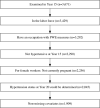Predicting the onset of hypertension for workers: does including work characteristics improve risk predictive accuracy?
- PMID: 35277589
- PMCID: PMC8914447
- DOI: 10.1038/s41371-022-00666-0
Predicting the onset of hypertension for workers: does including work characteristics improve risk predictive accuracy?
Abstract
Despite extensive evidence of work as a key social determinant of hypertension, risk prediction equations incorporating this information are lacking. Such limitations hinder clinicians' ability to tailor patient care and comprehensively address hypertension risk factors. This study examined whether including work characteristics in hypertension risk equations improves their predictive accuracy. Using occupation ratings from the Occupational Information Network database, we measured job demand, job control, and supportiveness of supervisors and coworkers for occupations in the United States economy. We linked these occupation-based measures with the employment status and health data of participants in the Coronary Artery Risk Development in Young Adults (CARDIA) study. We fit logistic regression equations to estimate the probability of hypertension onset in five years among CARDIA participants with and without variables reflecting work characteristics. Based on the Harrell's c- and Hosmer-Lemeshow's goodness-of-fit statistics, we found that our logistic regression models that include work characteristics predict hypertension onset more accurately than those that do not incorporate these variables. We also found that the models that rely on occupation-based measures predict hypertension onset more accurately for White than Black participants, even after accounting for a sample size difference. Including other aspects of work, such as workers' experience in the workplace, and other social determinants of health in risk equations may eliminate this discrepancy. Overall, our study showed that clinicians should examine workers' work-related characteristics to tailor hypertension care plans appropriately.
© 2022. The Author(s), under exclusive licence to Springer Nature Limited.
Conflict of interest statement
The authors declare no competing interests.
Similar articles
-
Occupation-level automation probability is associated with psychosocial work conditions and workers' health: A multilevel study.Am J Ind Med. 2021 Feb;64(2):108-117. doi: 10.1002/ajim.23210. Epub 2020 Dec 22. Am J Ind Med. 2021. PMID: 33350480
-
Associations of occupational attributes and excessive drinking.Soc Sci Med. 2013 Sep;92:35-42. doi: 10.1016/j.socscimed.2013.05.023. Epub 2013 Jun 4. Soc Sci Med. 2013. PMID: 23849277 Free PMC article.
-
Availability of and Participation in Workplace Health Promotion Programs by Sociodemographic, Occupation, and Work Organization Characteristics in US Workers.Am J Health Promot. 2019 Sep;33(7):1028-1038. doi: 10.1177/0890117119844478. Epub 2019 Apr 23. Am J Health Promot. 2019. PMID: 31014070
-
Psychological distress is more common in some occupations and increases with job tenure: a thirty-seven year panel study in the United States.BMC Psychol. 2023 Mar 31;11(1):95. doi: 10.1186/s40359-023-01119-0. BMC Psychol. 2023. PMID: 37004123 Free PMC article. Review.
-
Impact of summer programmes on the outcomes of disadvantaged or 'at risk' young people: A systematic review.Campbell Syst Rev. 2024 Jun 13;20(2):e1406. doi: 10.1002/cl2.1406. eCollection 2024 Jun. Campbell Syst Rev. 2024. PMID: 38873396 Free PMC article. Review.
Cited by
-
Personal, occupational and cardiovascular risk factors associated with elevated blood pressure in Brazilian firefighters: a cross-sectional study.BMJ Open. 2025 Jan 15;15(1):e088084. doi: 10.1136/bmjopen-2024-088084. BMJ Open. 2025. PMID: 39819918 Free PMC article.
References
Publication types
MeSH terms
Grants and funding
LinkOut - more resources
Full Text Sources
Medical


